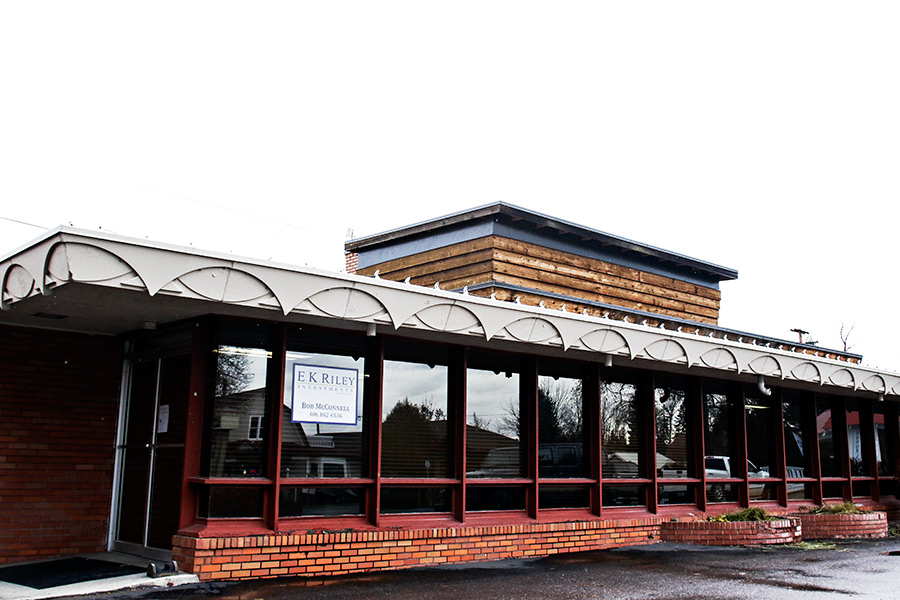An historic Whitefish building is slated for demolition to make way for a new three-story commercial development near downtown.
Mick Ruis, the developer behind the Cedar Creek Lodge and Convention Center in Columbia Falls, has purchased the Frank Lloyd Wright Building on Central Avenue and plans on tearing it down in the coming months.
The building, which until recently was home to the Morrison & Frampton law offices, is among the only Wright buildings in Montana and was one of the last he ever designed. Wright is one of America’s most famous architects and he designed more than 1,000 buildings before he died in 1959.
In 1958, Wright designed the Lockridge Medical Center in Whitefish but passed away before it was completed. The Central Avenue building on the south end of the downtown corridor features Wright’s modern style and, according to Northwest Montana Historical Society Executive Director Gil Jordan, was designed to feel like a comfortable home and not a doctor’s office. The 5,000-square-foot building has a large fireplace that is a focal point of the interior. In later years the structure was used as a bank and finally an office building. The building was added to the National Register of Historic Places in 2012.
Earlier this fall, Ruis met with the Whitefish Architectural Review Committee and received preliminary approval to construct a three-story structure at the site where the Wright building now stands.
Ruis told the Beacon he plans to create a retail space for lease on the bottom floor, professional offices on the second floor and four housing units on the third floor.
“Right now it is a law office where a few people work and some folks use the parking lot on weekends. This will create new jobs and incomes and create housing in an area that needs it,” he said.
Whitefish Planning Director Dave Taylor said the architectural committee would meet again on Dec. 6 to grant formal approval of the project. An official building permit could be issued three to four weeks after that meeting.
But the plan to tear down one of Montana’s only Wright buildings is ruffling feathers within the community.
“I’m stunned,” Jordan, with the Historical Society, said. “This is the most iconic building in Whitefish and to rip it down and ignore its history is a shame. This will be a loss for the community.”
Jordan added that it is particularly frustrating that the building is not protected from being torn down even though it is on the National Register of Historic Places. Taylor said there is nothing within the Whitefish city code preventing someone from tearing down an historic building.
George Gardner was on the Whitefish architectural committee until last year and echoed Jordan’s concerns about the historic structure being replaced.
“I think it’s a shame to tear down the only famous building in Whitefish. It makes no sense,” Gardner said. “This is among the last remaining Wright buildings in the state and that’s special.”
Two other Wright buildings have been preserved in the Bitterroot Valley. The two cabins were part of a planned community that Wright designed near Darby in the early 1900s.
Ruis, who divides his time between the Flathead Valley and California, is defending his decision to remove the building.
“All I’ve been trying to do in this valley is create jobs and create spaces for retail and places to live,” he said. “I’m trying to create jobs and incomes for families in this town. People should ask: Is it better for that building to stay there or is it better to create jobs for the valley?”
He said the owners of the Frank Lloyd Wright building, attorneys Ryan Purdy and Sean Frampton, contacted him about purchasing the property earlier this year. The initial goal was to construct new development around the original structure, Ruis said, but it ended up being unviable.
“I tried to see how I could work around it to make it a courtyard or something else,” he said. “But then we wouldn’t have any parking spaces for the building. I tried to see how I could save it, but at the end of the day it just didn’t make sense to keep it.”
Jordan said the historical society would support any effort to help save the building but acknowledged that it might be too late.
“People have a tendency to ignore history and it seems economics trumps everything,” Jordan said. “That’s what appears to be happening here.”
Dillon Tabish contributed reporting to this story.
